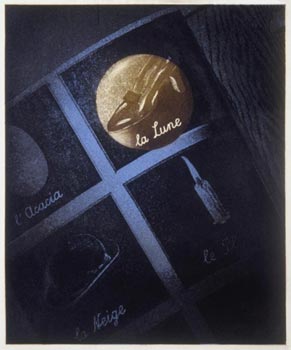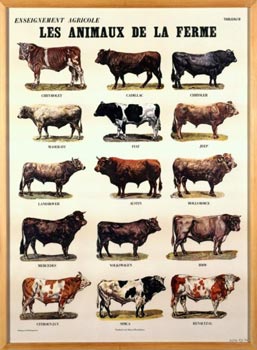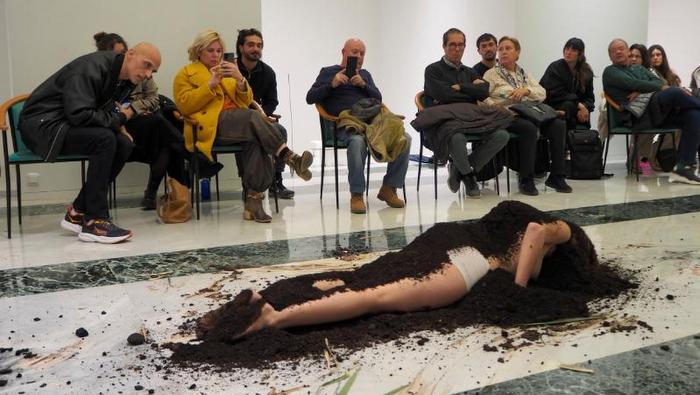New York: The Museum as Hub shows until July 3 at New Museum, The Incongruous Image: Marcel Broodthaers and Liliana Porter, works by Marcel Broodthaers (Brussels 1924-Colonia 1976) and Liliana Porter (Buenos Aries, 1941).
Bringing together the work of Broodthaers and Porter in one space, The Incongruous Image… proposes a dialogue or exchange of ideas explored by these two artists, highlights common points of interest, or philosophical agreements exploring knowledge, pedagogy and exhibition policies. Marcel Broodthaers described his genesis as an artist with the statement: “Finally the idea of inventing something insincere crossed my mind and I set to work straightaway.” Liliana Porter has said: “the only consciousness possible is doubt.” Positioning its enquiry between these spaces, The Incongruous Image looks to determine, by means of juxtaposition, how each artist investigates the deceptions, dissonances and incongruities that images and language can produce.
 The Incongruous Imageis, in part, a response, elaboration and critique of the first exhibition An accord is first and foremost only a proposition, organized by guest curator Sarah Rifky of the Townhouse Gallery, Cairo, and further anchors other related events organized by institutions associated in Cairo, Eindhoven, Mexico City and Seoul. The exhibition mirrors the spirit of exchange and experimentation in the topic of museums as center of initiative, instead of classis spaces for exhibition, picturing a dialogue between the artists through geographical, time and cultural contexts.
The Incongruous Imageis, in part, a response, elaboration and critique of the first exhibition An accord is first and foremost only a proposition, organized by guest curator Sarah Rifky of the Townhouse Gallery, Cairo, and further anchors other related events organized by institutions associated in Cairo, Eindhoven, Mexico City and Seoul. The exhibition mirrors the spirit of exchange and experimentation in the topic of museums as center of initiative, instead of classis spaces for exhibition, picturing a dialogue between the artists through geographical, time and cultural contexts.
On one hand, Broodthaers is veneered in Europe and United States. As Barry Barker said: “Sometimes his works are treated by some institutions as ancient relics instead of what they really are: the products of a vibrating and complex mind that has left us a heritage and that through objects, paintings and writings expresses a continuous understanding of the nature of human condition within an expanding cultural context.” Porter has lived in New York since 1964 and she is a pillar in the history of Latin American contemporary art, however her work has been shown in a limited number of exhibitions in the city where she lives.
Broodthaers and Porter are profoundly influenced by the work of Rene Magritte and surreal literature, exploring ways in which humor, mystery and self-criticism play key roles in the works of both artists. Important productions like Broodthaers’ slide projection Ombres Chinoise (1973-1974) and Porter’s photo etchings, The Magritte Series (1975–77), employ playful strategies to criticize the artist’s role. Other works by Porter expand the ideas about the unexpected connection or core of this exhibition.
In her photoengraving Picasso (1973), the fingers of the artist “enter” the visual plane of a Picasso’s engraving, and in Dialogue with Penguin (1999), the artist juxtaposes the wooden, black-and-white toy penguin with a golden Christ that functions as a plastic lamp. The two works are part of the series of “dialogues” by the artist in which she places objects from different periods and places within a unique frame of reference to evoke a range of possible resonances, answers and meanings. Porter will also present new works at the exhibition, including Untitled (Ship), 2011, a large painting hanging diagonally to a plastic toy boat leaking black paint.
As an exchange of ideas, resources and graph material, The Incongruous Image also explores how a museum collection can continue to be relevant to artistic activity and contemporary expression. Here, the Van Abbemuseum museum in Eindhoven activates its collection to lend significant and rarely seen works by Marcel Broodthaers to New Museum.
The Incongruous Imagemarks the first time a fair number of these works will be on show in New York. The exhibition includes Sex film (1971-72), the screening of 33 slides of casual notes and doodles by the artist, which hide the irreverent tone of the title of the work. Two plaques with the text Museum: enfant non admis play with the seriousness of traditional artistic institutions stating that children are not allowed in the museum. The Incongruous Image presents as well the large-scale piece Sereis de neuf tableaux (1972), containing nine prints with the names and important dates linked to personalities like Charles Baudelaire, Paul Valery, Andre Gide and Rene Magritte. Broodthaers presents each engraving with captions usually describing writers as painters and painters as writers–Charles Baudelaire peint (paints) and Rene Magritte écrit (writes)– a gesture that makes reference to Broodthaers’ own transformation from poet to visual artist.
Museum as Hub: The Incongruous Image: Marcel Broodthaers and Liliana Porteris organized by four guest curators Annie Fletcher, Van Abbemuseum, Eindhoven and Tobias Ostrander, Experimental Museum El Eco, Mexico City.
 Marcel Broodthaers
Marcel Broodthaers
During his 12-year career as visual artist, Marcel Broodthaers produced an amazing variety of works in a wide range of mediums, including enigmatic objects made out of egg shells and mussel, elegant typographic paintings, films, engravings, photographs and ephemeral and provocative installations. Heir of his Belgium colleague Rene Magritte, his work has been also associated to art Pop, Conceptualism, Dada and Minimalism. In addition to being extremely rich in references, Broodthaers’s production is basically enigmatic and its meaning is allusive. Instead of providing answers, Broodthaers’s work presents questions about the nature of art and the institutions protecting and sheltering it. Born in Brussels in 1924, Broodthaers was actively involved in the intellectual life of the city. By 1960 he had published two poetry books, had produced a film and was writing and giving lectures about art. His career as visual artists started in 1964 when he embedded in plaster fifty copies of his latest book of poems, Pense Bête. The first works that responded to American Pop artists like Jim Dine and George Segal included regular objects that he usually altered just by stamping his name. The series of fictitious installations of museums that came later explored the ways in which context is affected by the meaning of objects. Many of Broodthaers’ individual works, such as typographic paintings and plastic plaques explore the nature of problems related to language and conventionalisms, sometimes arbitrary supporting them.
Liliana Porter
Through humor, visual pranks and empathy, Liliana Porter’s art uses little elements to answer to big questions. Working a range of means of expression that include engravings, drawings, installations and films, the artist inquires into matters of representations, structure of reality and the desire of meaning. Liliana Porter was born in 1941 in Buenos Aires, Argentina. She lived in Mexico City between 1958 and 1961, where she studied visual arts at the Iberian American University. In 1964 she moved to New York where she still lives and works. Porter was the cofounder of the New York Graphic Workshop together with Luis Camnitzer and Jose Guillermo Castillo in 1956. During her 40-year career, she has received several prizes and recognitions including the Solomon R. Guggenheim Fellowship in 1980. Her work has been exhibit internationally and is represented in several public and private collections, including that of the Museum of Modern Art, New York; the Metropolitan Art Museum, New York; the Whitney Museum of American Art, New York; Tate Modern, London; National Museum of Fine Arts, Buenos Aires, Argentina; National Museum of Fine Arts, Santiago de Chile; Museum of Modern Art of Bogota; the Bibliotèque Nationale, Paris; Centro de Arte Reina Sofia National Museum, Madrid; Daros Collection, Zurich; and the Tamayo Museum, Mexico.
The Museum as Hub
The Museum as Hub is a partnership of six international art organizations supporting art activities and experimentation; it explores artistic, curatorial, and institutional practice, and serves as an important resource for the public to learn about contemporary art from around the world. Initiated by the New Museum in 2006, this partnership includes art space pool, Seoul, South Korea; Museo Experimental El Eco, Mexico City, Mexico; Museo Tamayo, Mexico City, Mexico; Townhouse Gallery, Cairo, Egypt; and the Van Abbemuseum, Eindhoven, the Netherlands. Museum as Hub at the New Museum is organized by Eungie Joo, Keith Haring Director and Curator of Education and Public Programs.
Museum as Hub is made possible by the New York City Department of Cultural Affairs and the New York State Council on the Arts. Endowment support is provided by the Rockefeller Brothers Fund, Skadden, Arps Education Programs Fund, and William Randolph Hearst Endowed Fund for Education Programs at the New Museum. Education programs are made possible thanks to the generous contribution of Goldman Sachs Gives at the recommendation of David and Hermine Heller.
As part of the activity program of the exhibit, Associate Professor in the Department of Art and Art History and the Graduate Program in Visual and Cultural Studies of the University of Rochester, Rachel Haidu will speak about the influence of Rene Magritte on Marcel Broodthaers’ art practice, and share viewpoints from her book The Absence of Work: Marcel Broodthaers, 1964–1976 (2010) at the New Museum’s theater, on Saturday, June 11, at 2 p.m.














